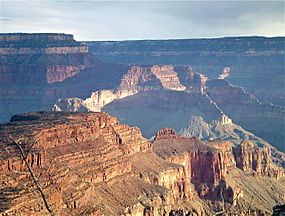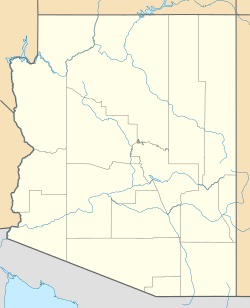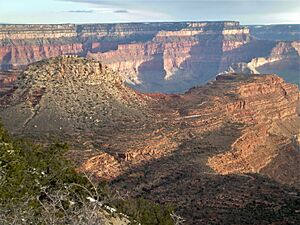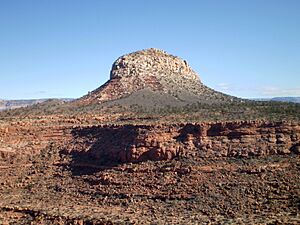Huxley Terrace facts for kids
Quick facts for kids Huxley Terrace |
|
|---|---|

(massif)-northeast terminus of Huxley Terrace
(Upper Bass Canyon-(right)) Masonic Temple, north across Colorado River |
|
| Floor elevation | 5,630 ft (1,720 m) |
| Length | ~1.2 mi northeast (connected to Mount Huethawali) |
| Width | ~0.3 mi |
| Geography | |
| Location | (west)-Grand Canyon, (northern)-Arizona, United States |
| Topo map | Explorers Monument, USGS |
| Rivers | Copper Creek (Arizona)-(Evolution Amphitheater), Bass Creek (Arizona) |
Huxley Terrace is a long, narrow, flat area of land in the western part of the Grand Canyon in Arizona, USA. It stretches northeast from a mountain called Mount Huethawali. This landform is like a flat-topped hill, about 1.2 miles (1.9 km) long.
Mount Huethawali is surrounded by three similar landforms. The Darwin Plateau is to the southwest. To the north of Mount Huethawali are two terraces: Spencer Terrace, which goes north-northwest, and Huxley Terrace, which goes northeast.
The middle of Huxley Terrace is about 1 mile (1.6 km) from Mount Huethawali. It's also about 1 mile northwest of the end of the Grand Scenic Divide. Huxley Terrace is located about 2 miles (3.2 km) south of a part of the Colorado River that flows west. This area includes the three terraces, two main canyons, and a smaller canyon between Spencer and Huxley Terrace. This small, narrow canyon is called Copper Creek (Arizona), and its upper part is known as the Evolution Amphitheater.
Geography and Features
Huxley Terrace is mostly flat, unlike Spencer Terrace to its west, which slopes downwards. The highest point of Huxley Terrace is at its northeast end, reaching about 5,630 feet (1,716 meters) above sea level. There's a slight dip, or saddle, on the terrace about one-third of the way from Mount Huethawali, at an elevation of about 5,440 feet (1,658 meters).
How Huxley Terrace Formed
Huxley Terrace is made up of a group of rock layers called the Supai Group. Specifically, it's protected by a very strong layer of rock known as the Esplanade Sandstone. This sandstone forms cliffs and flat platforms. The other two flat areas nearby, Spencer Terrace and the Darwin Plateau, are also made of this same Esplanade Sandstone.
Mount Huethawali itself is a large cliff made of Coconino Sandstone. Below this, there's a thick slope of Hermit Shale. Both of these layers sit on top of the Supai Group, which includes the Esplanade Sandstone.
At the highest point of Huxley Terrace, you can see colorful, dark reddish-brown rocks. These are pieces that have broken off from the Hermit Shale layer. The best places to see the cliffs of the Esplanade Sandstone are along the edges of the terraces.




